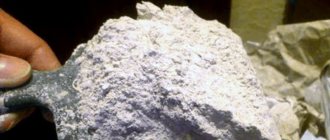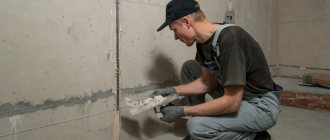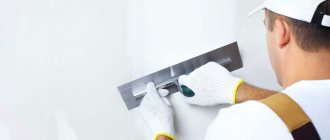Factors affecting the drying time of putty
The functionality of a building mixture is based on changes in its state and consistency. The dry composition is diluted with water to the desired condition, and then applied to the surface. The moisture gradually evaporates, and the applied composition acquires strength and hardness. How long the putty dries on the ceiling or walls depends on various factors.
Putty is the final stage of wall finishing before wallpapering or painting.
Environment
The drying time of the putty mixture is directly influenced by external conditions. For the material to harden, a temperature range between +18 °C and +20 °C is required. The humidity level should not exceed 65%. In addition, drafts should not be allowed in the room.
If these conditions are not met, not only the drying time of the putty changes, but also the quality of the coating, and not for the better. Due to the lower temperature, the entire technological process is disrupted. The quality of the putty also decreases.
Indoor humidity
Moisture directly affects the quality of leveling. Ideally, air humidity for a favorable hardening process of putty should be no more than 50%. If you increase the limit to 75–80%, the treated surface will dry much longer.
Air permeability
Good ventilation in the room helps to increase the speed of work without any negative consequences. The main thing is to avoid drafts. The specific drying time of the putty is influenced by the thickness of the layer, the characteristics of the base and the characteristics of the composition.
The room should be ventilated, but drafts should be avoided
Putty layer thickness
A competent technological process involves applying the mixture to the surface in several thin layers. Each new coating is applied only after the previous one has completely dried. The thicker and larger the layers, the longer the drying process will be.
Surface
Before work begins, the walls must be prepared for further processing. The surface must be smooth, dry and durable, no dust, grease stains, or old paint. If there are porous areas and other defects, a sealing primer is applied (before plaster and putty). Finally, brush the surface with a hard-bristled brush to remove any protruding particles.
The porosity of the wall promotes increased moisture absorption, which causes the putty to harden and crack faster. Pre-treatment with a primer avoids this problem.
Attention!
It is not recommended to lay putty on a fresh plaster layer. With a thickness of 1.5-2 mm, the coating will be ready in a day at optimal temperature and good ventilation.
A standard coat will dry within a week, based on its thickness. However, the longer you let the plaster dry, the stronger the surface will be - it’s better not to rush here. The coating will gain maximum strength after 26–28 days.
Before work, the base must be carefully prepared
When can further work be carried out?
Subsequent operations using finishing materials should begin only after the putty has completely dried. Otherwise, the owners risk encountering undesirable nuances and may have to redo everything all over again.
Painting
To understand when to start painting work, you need to know how long the finishing putty should dry on the walls before painting. If the coating thickness is no more than 3 mm, you will have to wait a day after applying the composition. But only if you adhere to optimal conditions. Deviations in temperature and humidity increase the waiting period to 2 days.
This is exactly the amount of time it will take to paint a plaster surface or plasterboard sheets (GKL). The same applies to tiling the walls of the bathroom and toilet with tiles.
When the putty on the walls or ceiling has already completely dried, it is recommended to coat the surfaces with a primer. It is undesirable to neglect the rule, since this has a positive effect on the adhesion of the paint to the treated surface. And when the primer coating is dry, you can begin painting work.
To determine the start date for painting, you should know how long the finishing putty takes to dry.
Second layer of putty
If it is necessary to apply a second putty layer, you need to wait until the hydration process in the starting coating is complete. The first layer always shrinks and for this reason, applying the next one inevitably leads to a loss of the appearance of the surface. Cracks and chips will appear.
In some cases, manufacturers recommend treating the first layer with a primer and waiting until it dries completely. Typically this takes 4 hours. Only then apply the second layer.
Wallpapering
Before gluing the wallpaper, you must wait until the surface has gained strength after applying the putty. Based on temperature and humidity indicators, this may take a period of 12 to 48 hours.
Taking this into account, it is better to start gluing wallpaper 2 days after the putty was applied. It is also advisable to cover the walls with a primer mixture in order to increase adhesion.
Wallpapering is possible only after the putty layer has fully gained strength.
A perfectly smooth wall surface has good adhesion during subsequent paint application. However, only if the putty is completely dry. This gap varies within a certain range among different manufacturers.
Did you learn something new? Share in the comments!











